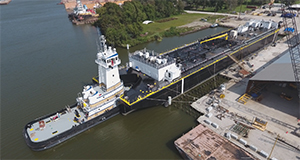The industry took notice last spring when Harley Marine Services welcomed Earl W. Redd, the first EPA Tier 4-rated tractor tugboat. A year later, the company has two more with OneCURE and Todd E. Prophet.
Conrad Shipyard built the 4,560-hp pusher tugs at its Morgan City, La., shipyard using plans from Entech Designs. They are paired with 80,000-bbl tank barges built by Gunderson Marine through an Articouple pin system. GE Tier 4 engines provide propulsion.
In all, Conrad built four articulated tug-barge (ATB) units for Harley Marine in 2017, including the 4,500-hp Tier 3 siblings Bill Gobel and Min Zidell. All four are working along the West Coast, where they serve ports in the continental U.S., Alaska and Hawaii.
The new vessels represent a doubling of Harley Marine’s ATB fleet to eight units, and it operates a ninth on charter. They also highlight further acceleration away from towed barges to articulated tug-barge units for moving petroleum products and chemicals.
“Not only is it great from a safety component, and an efficiency and reliability component, it adds value to the charterer so that they are getting better utilization for the vessel they employ,” Harley Franco, Harley Marine’s namesake president, said during a recent interview at the company’s Seattle headquarters. “When you’re a charter and you’re waiting for the weather to break and you are paying for a vessel to be sitting at the dock, your economics really get blown out.”
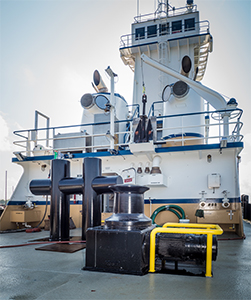 |
|
Harley Marine no longer installs winches on its ATB tugs. In its place on OneCURE is a Markey CEW-60 capstan and hefty H-bitt. |
|
Brian Gauvin |
Naval architect Frank Basile, who passed away in February, developed the hull used in OneCURE and its siblings more than a decade ago for conventional tugboats. More recently, the design was modified into an ATB tug by removing the double pilothouse, among other changes.
Kimia Jalili, who now owns Entech Designs in Kenner, La., the successor to Basile’s firm, said the hull form underwent additional changes in 2012 for Harley Marine’s first-generation ATBs. These included a new tank arrangement and engine foundations for GE Tier 3 mains.
Accommodating GE’s heavier Tier 4 mains required additional modifications, she said. For instance, the engine room bottom structure is half-inch plate with deep frames at every other frame. The engine foundations are also significantly stronger.
“The width of the hull generates a large stability margin,” Jalili said of the 36-foot beam. “The high tower and eye level (51.5 feet) accommodates a great visibility. I may be biased but I think it is a very visually pleasing looking tug with some traditional elements and smooth side profile in comparison to many other similarly operating tugs out there.”
OneCURE and its Tier 4 counterpart Todd E. Prophet are paired with their 80,000-bbl barges through an Articouple FRC 55 system located in the forward hold below the main deck. All eight of Harley Marine’s ATBs use Articouple pins, and the company considers them a competitive advantage.
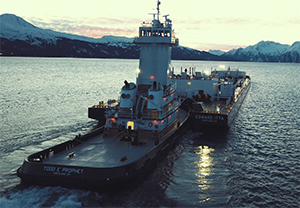 |
|
Naval architect Kimia Jalili considers Todd E. Prophet and its siblings “visually pleasing” ATB tugboats. |
|
Harley Marine Services |
Elliott Bay Design Group has designed several petroleum tank barges for Harley Marine Services over the years. The Seattle firm collaborated with Entech to ensure precise integration between the new tugs and their 428-foot barges.
“Design features include a ship-shape bow that reduces resistance and allows for better maneuvering and ship handling,” said Michael Complita, Elliott Bay’s principal in charge. “Our engineers have designed and optimized hull midbody to enhance fuel efficiencies and increase vessel speed.”
Although some U.S. and Gulf of Mexico operators run larger barges, Franco said the 80,000-bbl range is a good fit for the West Coast. That capacity aligns well with available storage tanks, and the relatively short hops from refineries to fuel ports is another factor.
“If you are going on a longer haul, bigger might be a better value,” he said. “But if you look at where the refineries are on the West Coast, it’s a nice setup for us.”
The four-tug order Conrad recently completed has two vessels with Tier 3 engines and two with Tier 4 mains. The split stemmed from the timing of the orders. Two were made before the Tier 4 cutoff, and two came afterward, said Matt Godden, Harley Marine’s senior vice president and chief operating officer.
The use of GE engines is a departure for a company that touts its longstanding partnership with Caterpillar. OneCURE and the three others are equipped with GE medium-speed engines, which are performing well. Godden said going with Caterpillar would have required redesigning the engine room to accommodate the urea-based aftertreatment system for Cat’s Tier 4 engines. GE’s Tier 4 engines use an on-engine method to cut emissions, and their footprints are similiar to their Tier 3 models.
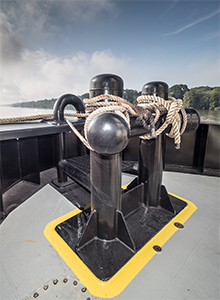 |
|
Conrad Shipyard installed the H-bitt on OneCURE’s bow. |
|
Brian Gauvin |
Propulsion on OneCURE and Todd E. Prophet comes from twin GE 6L250 engines generating 2,280 hp at 900 rpm. The mains turn four-bladed, 93-by-116-inch, open-wheel props through Reintjes WAF 1963 reduction gears. The electrical plant consists of 99-kW John Deere 6068 gensets.
Crewing on OneCURE and its three siblings is generally six people, although depending on the run could be as high as eight. Amenities include high-speed Internet access and cable TV in the mess and each cabin.
The wheelhouse is equipped with Furuno electronics. Closed-circuit cameras installed throughout the vessel also display on a wheelhouse monitor.
There are no towing winches on any of the new ATBs. Some earlier Harley ATB tugs do have winches, although the company has omitted them starting with Emery Zidell in 2014. The decision saves money and also recognizes the tugs will rarely, if ever, be needed for traditional wire towing. Harley’s newer ATB tugs do have H-bitts and Markey CEW-60 capstans for emergencies.
Although OneCURE has initially been paired with the barge Edward Itta, it will ultimately work with OneDREAM, and Todd E. Prophet will work with All Aboard for a Cure. Both barges have twin Volvo Penta 13L pump engines and electrical power from two John Deere 99-kW generators. Rapp Marine supplied the barge crane, anchor and six mooring winches.
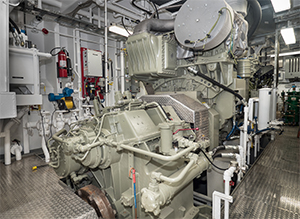 |
|
Propulsion on OneCURE comes from twin GE 6L250 Tier 4 mains paired with Reintjes WAF 1963 reduction gears turning 116-inch, four-bladed, stainless-steel props. |
|
Brian Gauvin |
OneCURE and OneDREAM honor Larry and Sherry Benaroya of the Benaroya Research Foundation, which performs diabetes research in the Pacific Northwest. Todd E. Prophet was a Harley Marine senior vice president and chief financial officer before he passed away from cancer.
Since Jan. 1, 2017, Harley Marine has taken delivery of four ATB tugs and barges, two ship-assist tugs and the versatile Earl W. Redd, which can perform ship handling, towing and ocean rescue. The fleet expansion will continue with two more ocean tugs under construction at Conrad Shipyard.
The Louisiana-based builder will deliver two 100-foot tugboats scheduled for delivery a few months apart in late 2018 and early 2019. Entech Designs provided plans for the 3,000-hp vessels that will be outfitted with Caterpillar Tier 4 engines. Diversified Marine of Portland, Ore., also is building the Tier 4 ship-assist tug Vern Patterson due out in early 2019.
Franco said the company also might build more ATB tugboats in the coming years as it looks to expand its coastal towing capabilities. “We like that 80,000-bbl spot,” he said, noting that the company also operates two 80,000-bbl towed barges.
“Probably, when … those 80s are towed into their shipyard haulouts, we will take a serious look at converting them to ATBs,” Franco continued. “We’d have to build two more tugs, but it would be replacing two mature tugs, so it makes a lot of sense.”

